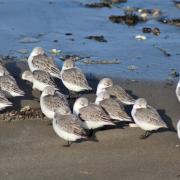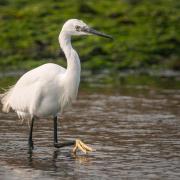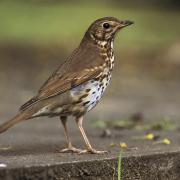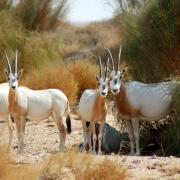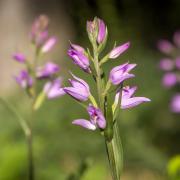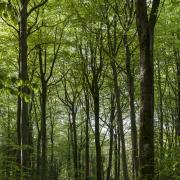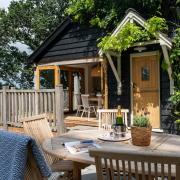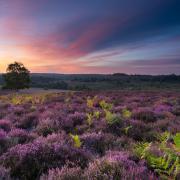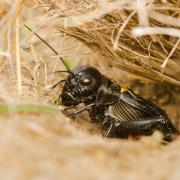Hampshire and the Isle of Wight are blessed with chalk downland habitat that is rich in wildlife, and much of it is managed by the Wildlife Trust. Chalk makes its presence felt in iconic landforms such as Portsdown Hill, the eastern edge of Salisbury Plain and the stunning chalk stacks of the Needles
Much of our two counties’ area is underlain with chalk, which formed from tropical sea sediments tens of millions of years ago. Following the ice ages, clays and other deposits overlaid parts of the chalk rock, but in places where there were only thin soils a characteristic flora and fauna established; plants adapted for dry, alkaline conditions took over, eventually culminating in a part of the wild wood dominated by ash and hazel.
During the Iron and Bronze Ages, human settlement and clearing land for sheep grazing often started on the chalk ridges, leading to a distinctive habitat: chalk grassland – a sunny and sometimes parched turf of fine grasses and lime-loving herbs. Some areas remained wooded, were subsequently planted, or colonised by trees following abandonment of grazing – these created some of our ancient wooded downs such as the Hampshire hangers.
Without grazing, chalk grasslands rapidly return to scrub and then to rather bland woodland. They lose their unique community of wildflowers and invertebrates, which include typical species such as the Adonis blue butterfly and burnt-tip orchid. A square metre of high quality chalk grassland may contain dozens of species of moss, lichen, grass and herb – some of which are the foodplants for several of the county’s rarest butterflies.
Chalk grassland is a classic habitat of Hampshire and the Isle of Wight; yet, most of it clings on within a scattered handful of nature reserves, disconnected from each other and under pressure from neighbouring land use and recreation. The Wildlife Trust’s Living Landscapes work seeks to expand and reconnect swathes of chalk downland. We are achieving these aims in a number of places where stepping stones and corridors are linking the larger fragments, which themselves are being restored for wildlife.
Chalky Destinations
Noar Hill
A short walk from Selborne, and a haunt of the grandfather of ecology Gilbert White, Noar Hill is as much pit as hill. Since it was abandoned for digging chalk, it has become a bubbling cauldron of biodiversity. Look for the unusual fairy shrimp in the puddles of the track ways – it completes its lifecycle in response to rain. Tread carefully and you will see fragrant orchids. Nationally high numbers of Duke of Burgundy and brown hairstreak are merely the tip of a butterfly iceberg of up to 30 species. The Wildlife Trust manages the reserve through sensitive grazing to ensure scrub is kept in balance and the height and structure of the grassland is just right to host the phenomenal concentration of species.
St Catherine’s Hill & The Dongas
St Catherine’s Hill in Winchester provides beautiful views of folding chalk hills and valleys. It is a good introduction to chalk grassland species: the papery-yellow rock rose, indigo-blue clustered bellflower, fragrant marjoram, and almost lurid pink pyramidal orchid. Across the bridge to The Dongas is a good place to see characteristic fine grasses such as sheep’s fescue, which must have been present here since these historic drove ways were first created. The Trust’s resident sheep flock helps maintain the scrub and open grassland across the whole area.
Kitts Grave
A taste of how vast tracts of chalk downland used to be, Kitts Grave is our newest nature reserve and it sits in a jigsaw of grasslands, scrub and woodland that make up the Martin Down National Nature Reserve. You might see the greater butterfly orchid along the wooded edges to the grassland. Listen for the call of ravens, which are a feature of the area and a reminder that this is part of a cross-county Living Landscape linking to Dorset and Wiltshire. A myriad of invertebrates thrive on the boundary between woodland, scrub and grassland.
For more information on these and other Wildlife Trust nature reserves, visit www.hiwwt.org.uk
News
If you love our regular wildlife feature from the folk at the Hampshire & Isle of Wight Wildlife Trust, then you can now enjoy the beautiful imagery that goes alongside it by purchasing their 2014 calender. After holding a competition to encourage the residents of Hampshire and the Island to take photos of the fantastic variety of nature and wild places to be found in the two counties, the trust has now produced a stunning array of photographs over the course of 12 months. There were over 2,300 entries of an extremely high standard and choosing the winners was no easy task, with their Vice President, Chris Packham, choosing the ultimate winning photograph from the twelve finalists, which is featured on the front cover of the calendar.
All monies raised from the sale of the calendar will go towards the conservation work of the Wildlife Trust.






